PPC Marketing For Veterinarians 101
Written by Jake Byrnes - Director of Optimization, GeniusVets
GeniusVets Chief Strategist David Hall wrote a blog about Veterinary Marketing 101. In it, he touched on using PPC to give your content a boost. Since that article was published, we’ve received some additional questions regarding the different PPC platforms, their ad types, and which ones are the most effective. So I thought I’d follow up his article with one of my own! Let’s start with the most basic question:
What is PPC?
PPC stands for Pay-Per-Click, a form of online advertising that charges you every time someone clicks on your ad. In its basic form, it’s pretty simple, right? However, the term PPC has evolved to encompass more than just simple pay-per-click ads. There are a number of different platforms, each with its own ad types, targeting options, and many other intricacies you should know before jumping in with both feet. Let’s start by looking at the different PPC ad types and the most popular platforms for each.
Popular PPC Ad Types & Platforms
Step 1 in driving more business to your veterinary practice using PPC is understanding the different types of ads you can run and choosing the best one based on your overall business goals.
Search Ads
The most popular type of PPC ad is known as a Search Ad, which allows you to jump to the top of the search engine results page (above the organic listings) by bidding on keywords you define. For example, let’s say we want our ad to show at the top of Google’s search results any time someone within a 5-mile radius of your practice searches for the term “veterinarian near me.” No problem! This can easily be done in Google Ads (formerly AdWords) to get your ads to the top of Google’s search results almost instantly. Once someone clicks on your ad, they will be sent to your website, and you will be charged a small fee, usually from $1-$4 per click.
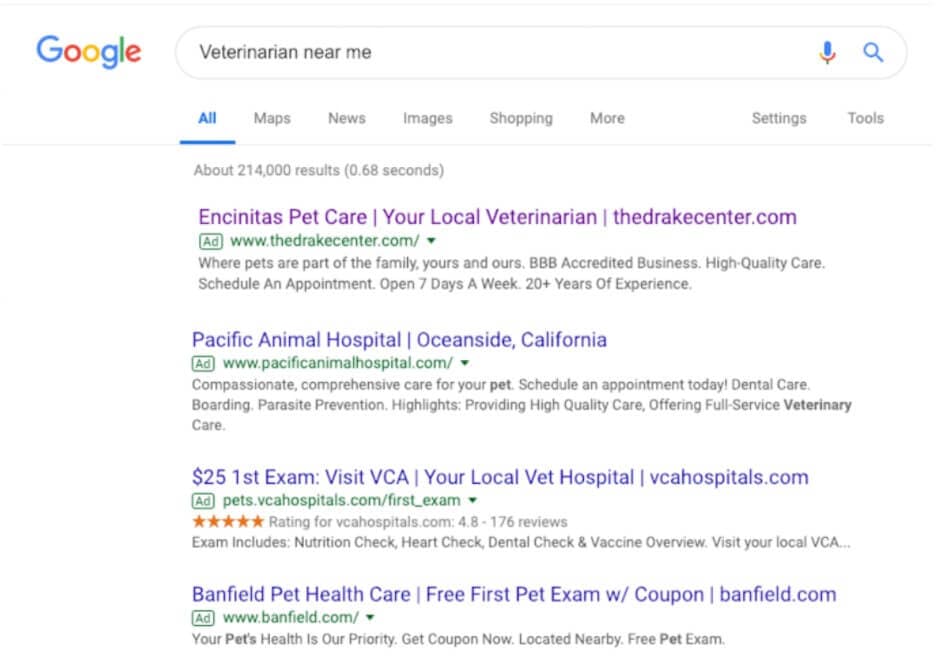
This can also be done on the Bing and Yahoo search engines using Bing Ads. However, we recommend sticking to Google Ads initially, as Google has over 92% of the worldwide search engine market share, while Bing and Yahoo account for just 4% combined.
Click-To-Call Ads
Click-to-call ads are a type of search ad in Google Ads geared towards local businesses - like veterinarians - who want to cut to the chase, skip the website visit, and go straight to triggering a phone call, which is precisely what these ads do. They are only shown on devices that can make phone calls, like mobile phones, and do exactly what they sound like. Instead of sending the user to your website when they are clicked, they automatically start a call to your practice.
Remarketing Display Ads
Another form of ad that is highly used all around the web is called the display ad. Display ads take the form of images displayed to users on websites all around the web. Display ads come in many shapes and sizes and typically appear at the top, bottom, and sides of web pages, before a video runs on YouTube and in your feed on social media. The Display ads we find most effective and use the most here at GeniusVets are called Remarketing Display Ads.
Have you ever looked at a product online, then 20 minutes later see an ad for that product on another website? That’s a display ad using a targeting called Remarketing. When we set up Remarketing ads for our clients, we ensure that the ads are only shown to people who match the following criteria:
- They are located within a 5-10 mile radius of your veterinary practice.
- They have already visited your website.
The click-through rate on these ads is low, typically between 0.5% and 1.5% click-through rate. However, the great thing about these ads is that you do not get charged when people see the ads, only when they click on them.
This means that, on average, people will see these ads between 70-200 times for every one time an ad is clicked. The average cost per click will typically be around $1. Therefore, this is an excellent way to generate inexpensive branding to keep your ads in front of highly targeted prospects.
Also, these types of campaigns tend to cause two really nice indirect benefits:
- A rise in branded search traffic. When Google sees an increase in branded search terms, your site will begin ranking better when people in your area search for veterinary-related information and services.
- An increase in direct traffic. This means that more people will start just typing your website URL into their browsers instead of going through search engines. This behavior is directly related to the familiarity of a good branding campaign.
Here’s an example of one of our client’s Remarketing display ads at work:
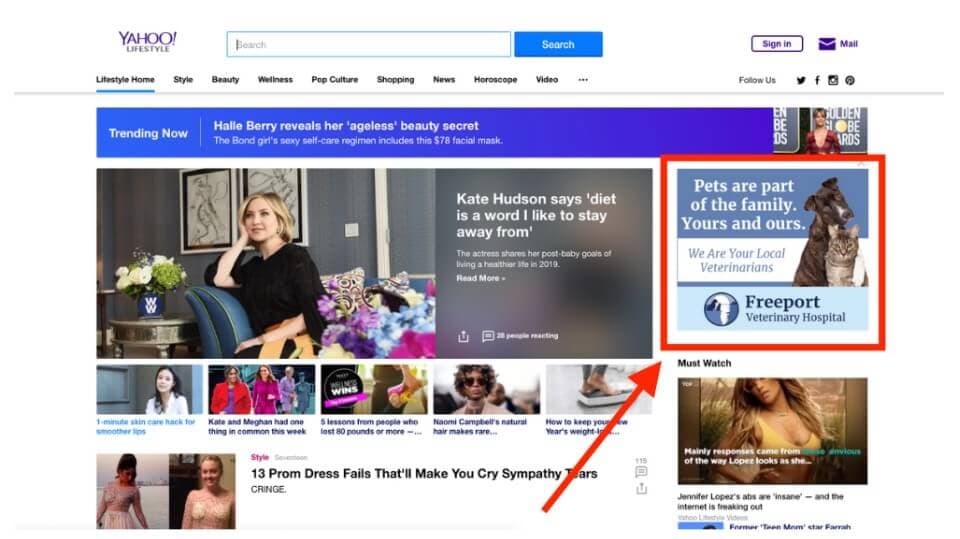
Local Service Ads
Google Local Services Ads offer a powerful advertising tool for veterinary practices looking to increase their local visibility. These ads appear at the very top of Google Search results, providing prime exposure to potential clients in your area. The key feature of Google Local Services Ads is the necessity for businesses to undergo a thorough verification process. This process includes checks for relevant licenses and insurance, ensuring that only legitimate, qualified professionals are advertised. Once verified, businesses can effectively target local clients, showcasing their services right when users are searching for them. This not only enhances trust in your practice but also significantly boosts local engagement and potential client outreach.
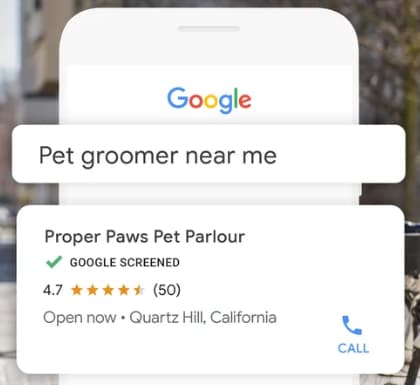
Performance Max Ads
Performance Max is like a supercharged advertising campaign on Google. It's designed for businesses who want to get the best results from their online ads. Imagine it as a one-stop shop for advertising where you can reach potential customers on various Google platforms like YouTube, Display ads, Search, Discover, Gmail, and Maps, all in one go.
Performance Max is really smart. It uses advanced technology to help you achieve your advertising goals and constantly learns and adjusts to give you the best results. It's like having a personal assistant that optimizes your ads in real-time, making sure you get the most value for your money. Plus, it's flexible. You can tell it what you want to achieve, like a target cost per acquisition (CPA) or return on ad spend (ROAS), and it tailors its strategies to meet your specific goals.
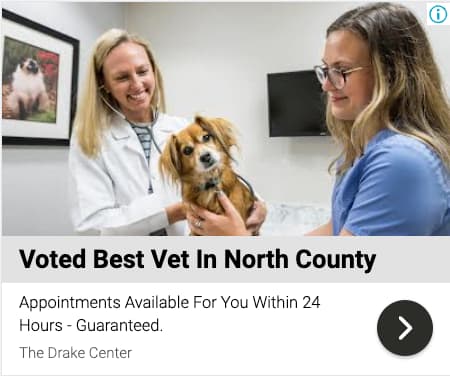
Social Media Ads
While there are numerous social media platforms, I’d like to focus on three of the most beneficial based on reach, targeting options, and ease of use. These platforms are Facebook, Instagram, and LinkedIn.
Each of these platforms allows you to run native ads that appear as posts in users’ timelines. Unlike display ads or banner ads, native ads don't really look like ads. They look like part of the editorial flow of the page. The key to native advertising is that it is non-disruptive, meaning it exposes the reader to advertising content without sticking out like a sore thumb. Here’s an example of a native ad in the Facebook news feed:
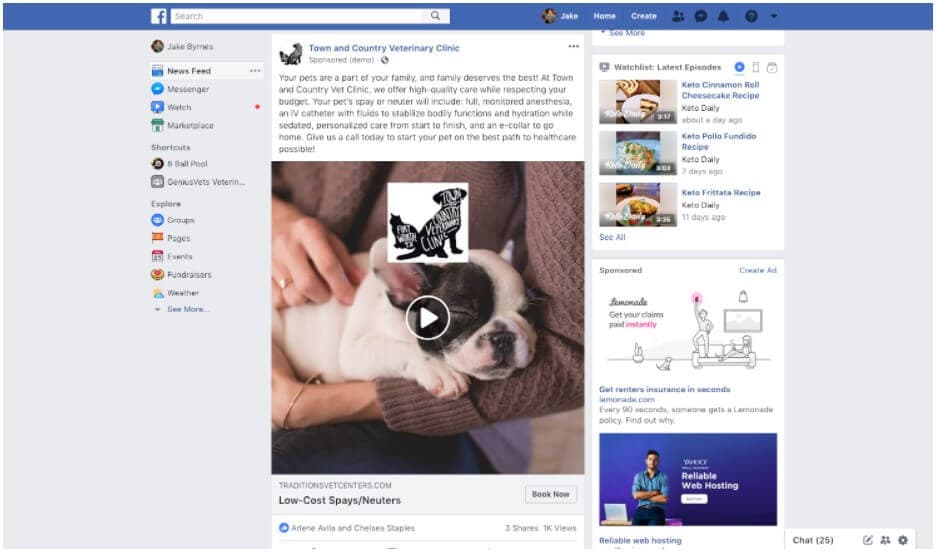
A study revealed that consumers looked at native ads 53% more frequently than regular display ads. Another great perk of advertising on social media platforms is their ability to target based on demographic and psychographic data, as well as location, but we’ll get into targeting in just a sec! For now, here is one last ad type we think you should know about...
How Does PPC Targeting Work?
Good question! It’s a bit different for every platform, so let’s go one by one through the ad types and platforms we mentioned in the previous section.
Search Ad Targeting Options
Search ad targeting is simple. You start by defining your location targeting. You can target the whole world or target a specific zip code. Want to do some radius targeting around your practice? That’s no problem! The granularity is phenomenal.
Next, to get your ad to show, you define a list of keywords you want to trigger your ad every time someone types them into the search engine you are advertising on. For example, say you want to show an ad promoting your low-cost vaccines on Google. You can create an ad that will show at the top of the search results anytime someone within your service area searches for “cheap dog vaccines near me.” Pretty simple, right?
Click-To-Call Ad Targeting Options
Targeting click-to-call ads is the same as search ad targeting. First, decide the locations you want your ad to show in, then determine which keywords you want to trigger your ads in the search results whenever someone searches for them.
Display Ad Targeting Options
Like nearly all PPC platforms and ad types, location targeting is your first option. After you have that set, there are several different options you can set for how you want your display ads to show to people; these options include:
- Interest Targeting: Show your ads to people as they browse other websites based on their interests. For example, you can show your display ads to people who have shown interest in animal products.
- Demographic Targeting: Show your ads to people in a certain age group, gender, parental status, household income, and more.
- Placement Targeting: Only show your ads on specific websites, such as websites with veterinary-themed topics.
- Behavioral Remarketing: Our favorite here at GeniusVets! Show your ads to people who have visited your website in the past but did not convert.
As you can see, there are many different options for targeting your display ads, which make them a viable option for veterinarians like you to be able to find that perfect audience to get to your site!
Social Media Ad Targeting Options
One of the best things about doing PPC advertising online is how granular you can get with your targeting, especially when it comes to advertising on social media platforms. Let’s take Facebook, for example. Facebook has become amazing at helping you define precisely who you want to see your ads, where they live, and what their interests are. Do you want to put a specific message in front of moms with kids who like pets and live within five miles of your veterinary practice? Easy.
Are you looking for a new employee? Try LinkedIn ads, where you can target based on the position title, company, or interests in specific professional publications. Pretty cool, right?
How Much Does PPC Cost?
One of the questions we get the most here at GeniusVets when we recommend our clients start PPC advertising is “How much does PPC cost?” and the answer is simple. It can cost however much you want!
Like previously mentioned, PPC stands for Pay-Per-Click, which means you set the price you want to pay every time someone clicks on your ad. However, it is important to remember that other competitors are bidding on the same set of keywords, so generally speaking, the higher you set your bids, the better chance you have of showing your ads above theirs. These bids can range anywhere from less than $1 per click on the low end to over $3 per click if you have a large number of competitors in your service area.
Our PPC experts here at GeniusVets have experience working with companies of all sizes: from Fortune 500 companies that spend hundreds of thousands of dollars per month to veterinarians like yourself that may have a more limited budget.
That is why we recommend starting with a $200-$500 budget per month. Based on experience, this should net your website an increase of anywhere from 250 to 600 highly qualified visitors per month. We know what you’re thinking: “That’s great, but how does it affect my bottom line?” Let’s take a look!
Is PPC Effective?
One of the main benefits of PPC, and online advertising in general, is that its performance is highly trackable. With the correct analytics and tracking set up, we can follow your ad budget all the way down the acquisition funnel, starting with clicks to your website to appointments scheduled and revenue generated. This allows us to effectively measure the return on investment of your ad spend and make improvements on the fly and improve performance as we go.
Examples From GeniusVets Clients
Let’s take a look at some examples from our clients!
Case Study 1

In this example, launching PPC resulted in a 304% increase in website visitors in just 3 months, with a total goal value increase of 795% during the same time period.
Case Study 2

In this example, launching PPC resulted in a 127% increase in website visitors in just 3 months, with a total goal value increase of 276% during the same time period.
Case Study 3

In this example, launching PPC resulted in a 60% increase in website visitors in just 3 months, with a total goal value increase of 730% during the same time period.
Beginning The PPC Journey For Your Veterinary Practice
By now, we hope you have a better understanding of the different PPC platforms, ad types, targeting options, ad costs, and effectiveness related to your veterinary practice. However, it is essential to keep in mind that while PPC advertising can work wonders in improving your bottom line, a lot goes into creating and managing an effective campaign.
Knowing this, veterinary practice owners should be mindful of who they choose to manage their PPC campaigns and ad budget. We understand that as a veterinarian, you’re already stretched pretty thin when it comes to running your practice. So whether it's an in-house marketing employee with PPC experience, or a full-time veterinary marketing partner like GeniusVets, staying on top of your practice’s PPC marketing can play an essential role in continuously increasing your bottom line.
Don’t Have PPC Set Up Yet?
No problem! We’d love to talk to you about how working with our PPC experts here at GeniusVets can benefit your veterinary practice moving forward.
Already Running Your Own Campaigns?
If you already have PPC campaigns running and would like a free evaluation from one of our PPC experts, please reach out and set up a GeniusVets Demo, which will not only help you with this but will show you how we can help you make expert hires and improve your profitability.

